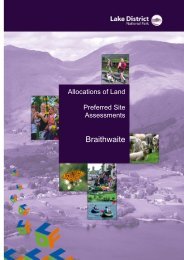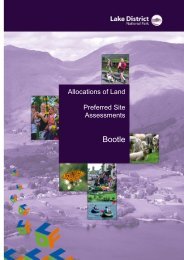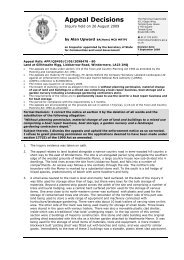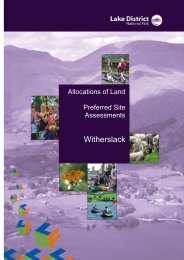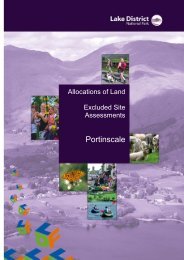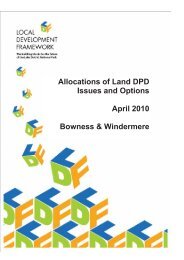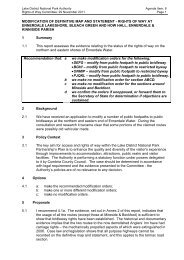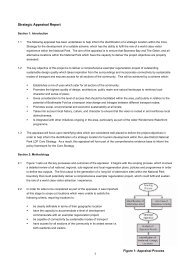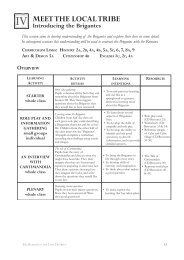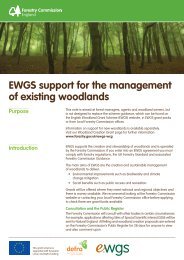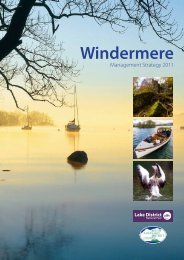The Partnership's Plan - Lake District National Park
The Partnership's Plan - Lake District National Park
The Partnership's Plan - Lake District National Park
Create successful ePaper yourself
Turn your PDF publications into a flip-book with our unique Google optimized e-Paper software.
Authenticity<br />
<strong>The</strong> <strong>Lake</strong> <strong>District</strong> contains extensive archaeological remains of the prehistoric, Roman and<br />
early medieval periods. We can trace Medieval origins in the existing stonewalled field<br />
systems, village plans and ecclesiastical architecture. <strong>The</strong> farming landscape of the 18th<br />
century with its distinctive farmhouses, barns, field walls and native woodland survives<br />
alongside the remains of important local industries.<br />
<strong>The</strong> tradition of upland hill farming in the <strong>Lake</strong> <strong>District</strong> is based on the indigenous Herdwick<br />
sheep and other local breeds and has a rich cultural heritage that survives to the present day.<br />
This is in large part due to the continuity of farming families in the <strong>Lake</strong> <strong>District</strong> over long<br />
periods of time.<br />
<strong>The</strong>re are a number of important examples of villas and designed landscapes built as a result<br />
of the Picturesque interest in the <strong>Lake</strong> <strong>District</strong>. Many tree planting schemes of that period<br />
survive. <strong>The</strong> farming landscape and stunning natural features which inspired the Romantic<br />
poets can be seen today alongside key residences, collections and places with important<br />
artistic and literary associations.<br />
<strong>The</strong> successes and failures of early environmental battles to protect the <strong>Lake</strong> <strong>District</strong> are<br />
reflected in the landscape. <strong>The</strong> <strong>National</strong> Trust owns and manages 25 per cent of the <strong>National</strong><br />
<strong>Park</strong> which includes some of the Trust's earliest acquisitions. And the1951 <strong>National</strong> <strong>Park</strong><br />
boundary encompasses all the attributes which exemplify Outstanding Universal Value.<br />
Integrity<br />
<strong>The</strong> boundary of the proposed World Heritage Site matches the <strong>National</strong> <strong>Park</strong> boundary.<br />
When designated, the <strong>National</strong> <strong>Park</strong> included the landscapes that characterised the special<br />
qualities of the <strong>Lake</strong> <strong>District</strong>. <strong>The</strong>se align with the elements of Outstanding Universal Value<br />
and the boundary would guarantee the integrity of the World Heritage Site.<br />
<strong>The</strong> continuing tradition of upland farming and the slow pace of change in the <strong>Lake</strong> <strong>District</strong><br />
have underpinned the survival of the historic elements of the farming landscape that were in<br />
place by the end of the 18th century. <strong>The</strong> farming infrastructure of stone walls and buildings is<br />
maintained by a farming community which takes pride in the skills that make this possible.<br />
<strong>The</strong> same applies to managing the hefted flocks of local sheep. Traditional methods of<br />
shepherding have been passed down over many generations. This has been assisted by the<br />
purchase and protection of key farms by the <strong>National</strong> Trust, financial investment in wall and<br />
building repairs and through agri-environment grant schemes. <strong>The</strong> majority of the buildings of<br />
the late 16th and early 17th century have survived in their original form and maintenance and<br />
repairs have been carried out using traditional materials and techniques.<br />
<strong>The</strong> system of development management and planning control implemented by the <strong>National</strong><br />
<strong>Park</strong> Authority ensures that new development is appropriate to its context.<br />
<strong>The</strong> residences, collections and associated landscape features of the Romantic poets have<br />
also been maintained through a combination of traditional management by the local<br />
community and by the <strong>National</strong> Trust and other conservation organisations. <strong>The</strong> Wordsworth<br />
Trust manages Dove Cottage and its collection of over 80 per cent of William Wordsworth’s<br />
original manuscripts. And the Brantwood Trust manages and conserves Ruskin’s house and<br />
grounds at Brantwood near Coniston Water.<br />
84



